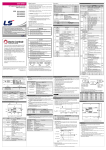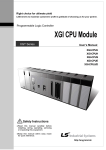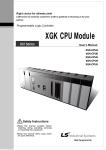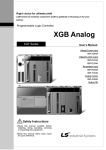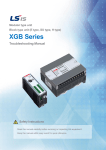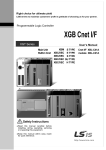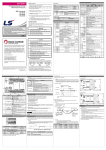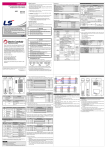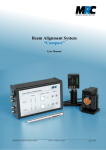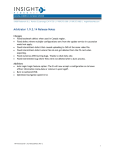Transcript
DATA SHEET LS Programmable Logic Controller XGB(IEC) Compact Type XGB If you violate instructions, it can cause death, fatal injury or a Warning considerable loss of property Caution If you violate instructions, it can cause a slight injury or a slight loss of products ► The symbols which are indicated in the PLC and User’s Manual mean as follows. This symbol means paying attention because of danger of injury, fire, or malfunction ► This symbol means paying attention because of danger of electric shock. Store this datasheet in a safe place so that you can take it out and read it whenever necessary. Always forward it to the end user Handling Precautions ► Don’t drop or make impact. ► Don’t detach PCB from case. It may cause problem. ► When wiring, let no foreign material go into the module. If it goes into the module, remove it. ► Don’t detach the module from slot while power is on Related Manual Read this data sheet carefully prior to any operation, mounting, installation or start-up of the product. Name Code XG5000 User’s Manual (Programming software) 10310000834 XGI Instruction & Programming User’s manual 10310000833 XGB Hardware User’s Manual (IEC Type) 10310000983 XGB Analog User’s Manual 10310000920 XGB Position User’s Manual 10310000927 XGB Cnet I/F User’s Manual 10310000816 XGB Enet I/F User’s Manual 10310000873 Revision History Issued date 2008.12 2010.09 2011.05 Warning No 1 LSIS(ME) FZE _ Dubai, U.A.E. Tel: 971-4-886-5360 Fax: 971-4-886-5361 LSIS Tokyo Office _ Tokyo, Japan Tel: 81-3-3582-9128 Fax: 81-3-3582-2667 LSIS Shanghai Office _ Shanghai, China Tel: 86-21-5237-9977(609) Fax: 89-21-5237-7189 4 Vibration resistance 5 Shocks resistance Caution ► Be sure to check the rated voltage and terminal arrangement for the module before wiring work. Risk of electric shock, fire and malfunction. e-mail: [email protected] ► Tighten the screw of terminal block with the specified torque range. If the terminal screw is loose, it can cause fire and electric shock. . e-mail: [email protected] ► Use the PLC in an environment that meets the general specifications contained in this datasheet. Risk of electrical shock, fire, erroneous operation and deterioration of the PLC. e-mail: [email protected] e-mail: [email protected] LSIS Guangzhou Office _ Guangzhou, China Tel: 86-20-8328-6754 Fax: 86-20-8326-6287 e-mail: [email protected] LSIS Chengdu Office _ Chengdu, China Tel: 86-20-8328-6754 Fax: 86-20-8326-6287 e-mail: [email protected] ► Do not use the PLC in the environment of direct vibration Risk of electrical shock, fire and erroneous operation. 10 ► Do not disassemble, repair or modify the PLC. Risk of electrical shock, fire and erroneous operation 11 Others PLC A) Best 10310000979 Ver 3.0 3. Parts Names and Descriptions No ① ② ③ ④ ⑤ ⑥ ⑦ ⑧ ⑨ ⑩ ⑪ Name Input status LED Description ■ Indicates input status. ■ Connector to connect with external PADT Connector device(XG5000) • USB(USB 1.1 supported) 1 Ch., RS-232C 1 Ch. Input TB ■ Input Terminal Block Output TB ■ Output Terminal Block ■ It sets the operation mode of XGB PLC. - STOP → RUN : Operation execution of program RUN/STOP Mode - RUN → STOP : Operation stop of program Switch (In case of STOP, it can be changed to remote mode.) Output status LED ■ Indicates output status ■ Indicates the operation status of the CPU. - PWR(RED) : Indicates power status. On : normal status Off : abnormal status or off - RUN(GREEN) : RUN status On : Run Operation status LED Off : Stop - Error(RED) : Indicates an error status Off : Normal Flicker: An error is detected by self diagnostic during operation Built-in Communication ■ Built-in RS-232C/485 Terminal Block TB Power TB ■ Power Terminal Block Battery Holder ■ Battery(3V) holder for data back-up ■ Dip Switch for setting operation or O/S O/S Mode Dip Switch download mode ► ► ► ► ► (1) I/O No. Allocation grants address to unit & module for input/output data. Main Unit Expansion Unit Maximum No. of module can be mounted Mounting Module Expansion I/O module 10 Analog I/O module 10 Communication module 2 (2) The following is method of I/O number allocation. Area Item Remarks Input Output Main Unit %IX0.0.0~%IX0.0.63 %QX0.0.0~%QX0.0.63 128point fixed Expansion #1 %IX0.1.0~%IX0.1.63 %QX0.1.0~%QX0.1.63 128point fixed Expansion #2 %IX0.2.0~%IX0.2.63 %QX0.2.0~%QX0.2.63 128point fixed -. I/O allocation for all expansion modules is fixed at 128points (The unused area can be used as internal relay.) - 5 ~ 95%RH, non-condensing - 5 ~ 95%RH, non-condensing - For discontinuous vibration Acceleration Amplitude Frequency times 10≤f∠57 Hz 0.075 mm 10 times in 57 ≤f≤150 Hz 9.8㎨ (1G) each For continuous vibration direction Acceleration Amplitude Frequency for 10≤f∠57 Hz 0.035 mm X, Y, Z 57≤f≤150 Hz 4.9㎨(0.5G) Max. impact acceleration : 147 ㎨ (15G) Authorized time : 11㎳ Pulse wave : Sign half-wave pulse (Each 3 times in X,Y,Z directions) Square wave AC: ±1,500V impulse noise DC: ±900V Electrostatic Voltage: 4kV (Contact discharge) discharge - Radiated electromagnetic field noise Segment Power supply module Voltage 2 kV Digital/analog input/output communication interface 1 kV No corrosive gas or dust Others PLC Others B) Good C) Bad Connect expansion connector correctly when expansion module is needed. Do not detach PCB from the case of the module and do not modify the module. Turn off power when attaching or detaching module. Cellular phone or walkie-talkie should be farther than 30cm from the PLC. Input signal and communication line should be farther than 10cm from a hightension and a power line in order not to be affected by noise and magnetic field. XECDR32H (/D1) - 2 or less - Natural air cooling - 384 352 384 8KB 4KB 10KB U 1KB Analog flag 20KB, 2blocks Using R device Data keeping method at power failure PID Control function Cnet I/F Special flag Link flag P2P flag No limit in points (Time range: 0.001~ 4,294,967.295 s) No limit in points (Counter range: 64 bit range) RUN, STOP, DEBUG Cold, Warm 128 1 8 8(%IX0.0.0~%IX0.0.7) 8 Watchdog Timer, Memory error detection I/O error detection, etc. Setting to latch area at basic parameter 10 Controlled by instruction, Auto tuning, PWM Operation Manual output, Operation scan time setting, Anti Windup, Delta MV, PV tracking, Hybrid Operation, Cascade Operation XGT Dedicated protocol support MODBUS protocol support User defined protocol support Selects one port between RS-232C 1 port RS-485 1 port by parameter speed Mode H S C and 1 phase: 100kHz 4 Ch. / 20kHz 4 Ch. (10kHz 4Ch)※1 2 phase: 50kHz 2 Ch. / 10kHz 2 Ch. (5kHz 4Ch) ※1 32bit signed counter Function Internal/External preset function Latch counter function Comparison output function Revolution number per unit time function Control axis: 2axes Control method: PTP/ speed control Control units: pulse Positioning data: 80 data per axis Positioning mode: End/Keep/Continue, Single/Repeat Position-ing Positioning method: Absolute/Incremental Positioning address: -2,147,483,648 ~ 2,147,483,647 Speed: Max. 100kpps(Setting range:1 ~ 100,000) Accel./Decel. Method: Trapezoidal method Operation method Return to Origin JOG Addition-al function Input filter Internal current consumption(mA) Weight(g) (1) Dedicated communication XGB(IEC) Compact Type has built-in Cnet communication function, and can communicate with various external devices without expansion Cnet I/F module. By using XGT dedicated protocol, user can read, write, and monitor memory devices of XGB(IEC) Compact Type Main Unit. (XGB(IEC) Compact Type Main Unit has built-in RS-232C and RS-485.) Built-in Cnet of XGB Main Unit supports the following functions. (a) Read single/continuous device (b)Write single/continuous device (c) Register monitoring device (d) Execute monitoring (e) 1:1 connection between LS PLCs (2) User defined communication User can define an user-defined protocol to communicate with other manufacturer’s devices. By supporting user-defined protocol, XGB PLC can communicate with various devices which have their own protocol. (3) Modbus protocol XGB PLC includes Modbus protocol, and it is easy to connect to Modbus devices. (It is not necessary to write Modbus protocol as user-defined protocol.) (4) P2P communication support XGB PLC supports client function service with P2P form to above item. Remarks 1) Please refer to XGB Cnet I/F User’s Manual for the details of built-in Cnet I/F function. 9. Other Built-in Function (1) Pulse Catch Function In the main unit, 8 pulse catch input contact points(%IX0.0.0~%IX0.0.7) are internalized. Through using this contact point short pulse signal(min. 10 - 50㎲) which cannot be executed by general digital input can be taken. (a) Usage When narrow pulse signal is input which can not be executed by general digital input, the operation can not performed as user's intention. But in this case through pulse catch function even narrow pulse signal as 10㎲ min. can be executed. (b) Operation Explanation Pulse width: 10㎲ 4points(%IX0.0.0~%IX0.0.3) 50㎲ 4points(%IX0.0.4~%IX0.0.7) Basic Remark Reiterative operation, fixed cycle operation Interrupt operation, constant period scan Scan synchronized batch processing method I/O control method (Refresh method) Direct method by instruction Ladder Diagram (LD), Programming SFC ( Sequential Function Chart), Language ST (Structured Text) Operator 18 Numbe Basic function 136 + Floating-point Arithmetic Functions rs of Basic function 43 Instruc block tio-ns Special Each special module has own special function function block blocks. Execution Time Basic instructions: 0.083㎲/step 1 pulse operation Mode : INC/DEC count by program 1 pulse operation Mode : INC/DEC count by phase B pulse input 2 pulse operation Mode : INC/DEC count by input pulse 2 pulse operation Mode : INC/DEC count by difference of phase Operation Pulse Catch 8. Built-in Communication Function (2) Instructions for PID control For the PID Operation of XGB PLC, there are four instructions as follow. No. Instruction Function 1 PIDRUN Perform the PID operation 2 PIDAT Perform the auto tuning operation 3 PIDCAS Perform the PID cascade operation 4 PIDHBD Perform the PID hybrid operation 352 4 counter modes are supported based on input pulse and INC/DEC method (1) Summary The high-speed counter can count high frequency pulse which can not be processed with the CPU counting instructions. It can count pulse which occurs from encoder or pulse generator. (2) Performance specifications Item Specification Signal A Phase, B Phase, Preset Input Signal Signal level DC24V Signal Type Voltage Input Counting Range -2,147,483,648 ~ 2,147,483,647(Binary 32Bit) 1 phase: 100kHz 4 Ch. / 20kHz 4 Ch. Max. counting speed 2 phase: 50kHz 2 Ch. / 10kHz 2 Ch. Count Method Linear Counter / Ring Counter 1 pulse operation Mode : INC/DEC count by program 1 pulse operation Mode : INC/DEC count by phase B pulse input Counter mode 2 pulse operation Mode : INC/DEC count by input pulse 2 pulse operation Mode : INC/DEC count by difference of phase (4 multiplication) Internal/External preset function Latch counter function Additional function Comparison output function Revolution number per unit time function The following describes the built-in PID function of XGB PLC.(Max. 16 loops) (1) The characteristics of PID function of XGB PLC (a) The PID function is integrated into the CPU module. Therefore, PID control can be performed with instructions and parameter without any separated PID module. (b) CASCADE and Hybrid operation are available. (c) P operation, PI operation, PID operation and On/Off operation can be selected easily. (d) The manual output (the user-defined forced output) is available. (e) By proper parameter setting, stable operation can be achieved regardless of external disturbance. (f) The operation scan time (the interval that PID controller gets a sampling data from process) is changeable for optimizing to the system characteristics. (g) PWM operation is supported. (h) SV-Ramp, Delta-MV function is supported. 384 L N Maximum expansion module IEC61131-2 IEC61000-4-4 5. Built-in High Speed Counting Function 6. PID Control Function 352 32KB (Max. 16K byte retain setting available) K - XECDP64H 200KB System flag IEC61131-2 IEC61000-4-2 2000m or less XECXECXECXECDR64H DN32H DN64H DP32H (/D1) Each special module has own special function blocks. Basic instructions: 0.083㎲/step 2KB task IEC61131-2 IEC61000-4-3 80 ~ 1,000 MHz, 10 V/m 43 F Internal device task LSIS standard 18 136 + Floating-point Arithmetic Functions Same area with R Self-diagnostic functions IEC61131-2 Remark XECDP64H 20KB Counter Operation Mode Restart modes Numbers of program Initialization task Time driven task External contact Task IEC61131-2 2. Performance Specifications Item Origin detection when approximate origin turns off. Origin detection after declaration when approx. origin on Origin detection by approximate origin XECDN32H XECDN64H XECDP32H XECDP64H Setting range: 1 ~ 100,000(High/Low speed) Inching operation, Speed synchronizing operation, Position synchronizing operation, linear interpolation operation etc. Only Select for 1,3,5,10,20,70,100㎳ (For each module) 660 1,040 260 330 300 380 600 900 500 800 500 800 (3) External interrupts function XGB PLC can perform max 8 points of external contact task by using input of main unit without special interrupt module (a) Usage This function is useful to execute a task program set to an external input signal. (b) Operation Explanation External input signal Scan program In case of occurrence of external interrupt signal pauses being executed scan program and processes interrupt program Scan program Interrupt Program Ends the interrupt program process then resumes to execute scan program. (c) Function It can be use the max. 8 point input( %IX0.0.0 ~ %IX0.0.7). Input 8 points(%IX0.0.0 ~ %IX0.0.7). of XGB(IEC) Compact Type Main Unit are shared for several functions as following table. Each of the functions can be disabled according to whether other functions are enabled. High Speed External Input Point Pulse Catch Input Filter Counter Interrupt %IX0.0.0 Ch0 Input Disable Disable Usable %IX0.0.1 Ch1 Input Disable Disable Usable %IX0.0.2 Ch2 Input Disable Disable Usable %IX0.0.3 Ch3 Input Disable Disable Usable %IX0.0.4 Ch4 Input Disable Disable Usable %IX0.0.5 Ch5 Input Disable Disable Usable %IX0.0.6 Ch6 Input Disable Disable Usable %IX0.0.7 Ch7 Input Disable Disable Usable 10. Dimension (㎜) Input signal Input image data scan1 scan2 scan3 Step 7. Positioning Function 4. I/O No. Allocation Method -25 ~ 70℃ XECDP32H W Timer Ambient conditions Operating height Pollution degree Cooling type Precautions for use ► Do not Install other places except PLC controlled place. ► Make sure that the FG terminal is grounded with class 3 grounding which is dedicated to the PLC. Otherwise, it can cause disorder or malfunction of PLC PLC - Specification Homepage: http://eng.lsis.biz LS constantly endeavors to improve our products so that information in this datasheet is subject to change without notice. The date of issue: 2011.5 9 0 ~ 55℃ XECXECDN32H DN64H 2 KB (%IX15.15.63) 2 KB (%QX15.15.63) 16KB (Max. 8K byte retain setting available) 20KB (1block) Flash area Fast transient /burst noise 8 Standard Positioning LSIS Europe B.V., Netherlands Tel: +31 (0)20 654 1420 Fax: +31(0)20 654 1429 e-mail: [email protected] 7 ► Be sure that external load does not exceed the rating of output module. Risk of fire and erroneous operation. ► When disposing of PLC and battery, treat it as industrial waste. Risk of poisonous pollution or explosion. LSIS Qingdao Office _ Qingdao, China Tel: 86-532-8501-6068 Fax: 86-532-8501-6057 e-mail: [email protected] Noise resistance Specification Internal function LSIS Beijing Office _ Beijing, China Tel: 86-10-5825-6027(666) Fax: 86-10-5825-6028 Item Operating humidity Storage humidity 6 HEAD OFFICE LS Tower, 127, LS-ro, Dongan-gu, Anyang-si,Gyeonggi-do, 431-848, Korea Tel: 82-2-2034-4870 Fax: (82-2)2034-4648 e-mail: [email protected] Direct variable XECDR64H (/D1) M R Input variable(I) Output variable(Q) Flag variable Operating temperature Storage temperature ► Protect the product from being gone into by foreign metallic matter. Risk of fire, electric shock and malfunction. ► Risk of fire, electric shock and malfunction. Risk of injury and fire by explosion and ignition. Symbolic variable(A) 1. General Specifications 3 ► Do not contact the terminals while the power is applied. Risk of electric shock and malfunction. V3.0 Operator Basic function Basic function block Special function block Execution Time Program memory capacity. Max. I/O points Numbers of Instructions Descriptions First edition Add new models(XEC-DP32H/DP64H) KOREAN/ENGLISH data sheet integrated CI Changed Applicable version For system configuration, the following version is necessary. Applicable Item Version XG5000 V3.4 or above 2 - When using LSIS equipment, thoroughly read this datasheet and associated manuals introduced in this datasheet. Also pay careful attention to safety and handle the module properly. - Store this datasheet in a safe place so that you can take it out and read it whenever necessary. Version V1.0 V2.0 Specification XECDR32H (/D1) Item Data memory XEC-DR32H XEC-DN32H XEC-DP32H XEC-DR64H XEC-DN64H XEC-DP64H XEC-DR32H/D1 XEC-DR64H/D1 Safety Precautions ► Safety Precautions is for using the product safely and correctly in order to prevent the accidents and danger, so please go by them. ► The precautions explained here only apply to this module. For safety precautions on the PLC system, refer to User’s manual. ► The precautions are divided into 2 sections, ‘Warning’ and ‘Caution’. Each of the meanings is represented as follows. (1) Summary XEC-DN32/DN64H/DP32H/DP64H support 2-axes, 100kpps of positioning function. The purpose of this function is to control moving object by setting speed from the current position and stop them on the setting position correctly. (2) Performance specifications Item Specification Control axis 2axes Control method PTP, speed control Control unit Pulse Positioning data 80 data per axis Positioning method Absolute / Incremental Speed limit Max. 100kpps, Min. 1pps(unit of 1pps) Positioning address -2,147,483,648 ~ 2,147,483,647 Acceleration/ Trapezoidal method(0 ~ 10,000ms) Deceleration method Bias speed 1 ~ 100,000 pps Rated load voltage DC12/24V Operation mode End / Keep / Continuous mode Positioning function Return to origin, JOG, PWM output , Linear interpolation Execution contents CPU senses input when pulse signal of min. 10 to 50㎲, is input, then saves the status.(Note 1) Scan2 Used to turn on the region of input image. Scan3 Used to turn off the region of input image (Note 1) %IX0.0.0~%IX0.0.3: 10㎲, %IX0.0.4~%IX0.0.7: 50㎲ (2) Input Filter Function The input filter function can be used to reject noises. The filter constant from the range of 1-100㎳ can be designated on the main unit and each expansion module independently. (a) Usage Input signal status affects to the credibility of system where noise occurs frequently or pulse width of input signal affects as a crucial factor. In this case the user sets up the proper input on/off delay time, then the trouble by miss operation of input signal may be prevented because the signal which is shorter than set up value is not adopted. (b) Operation Explanation Input filter constant (Filter time) Scan1 Input signal Input image data Time Input signal Input image data Narrower width pulse than input filter constant is not considered as input signal. A XEC-DN32H/DR32H/DP32H : 114(㎜), XEC-DN64H/DR64H/DP64H : 180(㎜) 11. Warranty (1) Warranty period LSIS provides an 18-month-warranty from the date of the production. (2) Warranty conditions For troubles within the warranty period, LSIS will replace the entire PLC or repair the troubled parts free of charge except the following cases. (a) The troubles caused by improper condition, environment or treatment except the instructions of LSIS. (b) The troubles caused by external devices. (c) The troubles caused by remodeling or repairing based on the user’s own discretion. (d) The troubles caused by improper usage of the product. (e) The troubles caused by the reason which exceeded the expectation from science and technology level when LSIS manufactured the product. (f) The troubles caused by natural disaster. (3) This warranty is limited to the PLC itself only. It is not valid for the whole system which the PLC is attached to.
